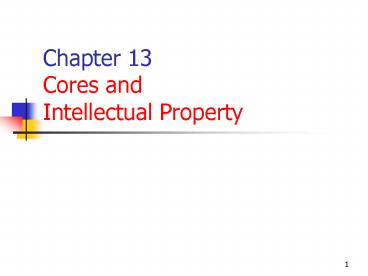Chapter 13 Cores and Intellectual Property - PowerPoint PPT Presentation
1 / 11
Title:
Chapter 13 Cores and Intellectual Property
Description:
Soft core: an HDL with no or minimal optimization for a specific target technology ... Hard core: design functionality implemented in fixed-logic at the gate ... – PowerPoint PPT presentation
Number of Views:73
Avg rating:3.0/5.0
Title: Chapter 13 Cores and Intellectual Property
1
Chapter 13Cores and Intellectual Property
2
Overview
- FPGA intellectual property (IP) can be defined as
a reusable design block (Hard, Firm or soft) with
a fixed-range of functionality - Two primary potential benefits of IP use
- Reduced design schedule and design
- Reduced development cost and risk
3
Types of IP
- Three commonly recognized types of IP
- Soft IP
- Firm IP
- Hard IP
- Soft core an HDL with no or minimal optimization
for a specific target technology - Firm core an HDL that has been optimized for a
specific target technology - Hard core design functionality implemented in
fixed-logic at the gate and signal route level.
The functionality cannot be removed or modified.
4
Categories of IP
- DSP function Viterbi decoder, FFT, MAC, FIR, DCT
- Math function Parallel Multiplier, Pipelined
divider - Base function Shift register, Accumulator,
Comparator, Adder - Memory function Block memory module, Distributed
module - Image processing Color space converter, JPEG
motion encoder - Communication AES compatible, Reed-Solomon
encoder, Turbo decoder - Microprocessor UART, CRT controller, Wstcching
timer - Std. Bus Interface LIN converter, PCI
master/target, USB, I2C, CAN
5
Trade Studies
- IP trade-off analysis can be a challenging
undertaking - A key factor that relates to IP type selection is
performance - Another important factor the amount and type of
resource required to most efficiently implemented
a complex function within an FPGA - Flexibility is often a primary objective in FPGA
design, and soft or firm implementations are
generally the most flexible
6
Make versus Buy
- Evaluating factors
- The size and experience of the design team
- Design schedule and budget
- How much functionality must be implemented
- The decision to make or buy an IP begins by
- Developing a through understanding of required
design functionality - The functionality of available IP blocks
7
Sources of IP
- FPGA vendors
- Third-party IP supplies
- IP libraries associated with an FPGA design tool
- Open access groups
- Universities
- Internally developed
8
Evaluating IP Option
- To evaluate and test potential IP blocks
- IP codes can be most efficiently evaluated when
they are implemented within the targeted FPGA
device - To understand that IP is generally not a seamless
turn-key plug-in solution - The quantity and quality of the design
documentation
9
Qualifying an IP Vendor
- IP vendor qualification question checklist
- The level of deign pre-verification completed
- Availability of test benches and test results
- Supplier experiment with the targeted FPGA
vendor/architecture component - IP vendor tool set used to generate, synthesize,
and simulate IP blocks - IP design flow and testing procedures
- Meet the system-level requirements
- Additional detailed discussions with the IP
suppliers regarding design details - Identify and maintain a backup approach with one
or more alternate vendors if possible
10
License, Tool, and Testing
- Licensing Issues
- License agreement with IP vendor, for each IP
code - Is the license project- or site-based?
- Can multiple versions of the same core be used on
a project? - Is multiple location support/implementation
allowed? - IP implementation/Tools
- IP testing/Debug
11
Q A































